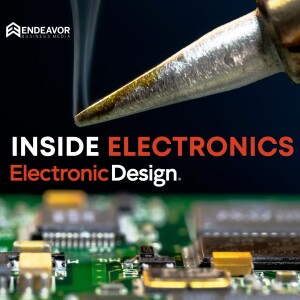Inside Electronics
Electronic Design has been serving the engineering community with pride for decades, providing news, commentary, and interviews about the industry. Hosted by industry veteran Alix Paultre, the Inside Electronics podcast brings you commentary, news, and interviews about the things going on in the electronic design engineering community and its surrounding business ecosystem.
Episodes

4 days ago
4 days ago
Today’s cloud is a polylingual, multi-spectral, multiple-methodology ecosystem, meaning that devices must become more intelligent to encompass it and operate in an optimal fashion. Today, one must have a wireless strategy for Wi-Fi, public cellular, private cellular, and IoT wireless backhaul. Companies like Nextivity offer solutions that enable wireless functionality for voice and data, with systems that are network safe and have a no-noise guarantee.

Tuesday Jul 08, 2025
Tuesday Jul 08, 2025
Residential energy storage is undergoing rapid innovation, driven by the need for efficient solar energy utilization and dynamic grid participation. Texas Instruments' Henrik Magnesson emphasizes that as feed-in tariffs decline and market-driven energy pricing becomes prevalent, homeowners will increasingly turn to battery energy storage systems (ESS) to store excess solar generation for use during peak demand, to charge EVs, or to exploit profitable energy arbitrage opportunities. Click here to listen to Part 1 of this chat.

Tuesday Jul 01, 2025
Tuesday Jul 01, 2025
This first, of a two part series, Inside Electronics podcast, guest-hosted by technology editor Andy Turudic of Electronic Design, features Henrik Mannesson, General Manager of Grid Infrastructure and Power Delivery Industrial Systems at Texas Instruments (TI), discussing the evolving landscape of energy infrastructure with a focus on the pivotal role of semiconductors in the renewable energy transition.

Tuesday Jun 24, 2025
Tuesday Jun 24, 2025
Not every microcontroller can handle artificial intelligence and machine learning (AI/ML) chores. Simplifying the models is one way to squeeze algorithms into a more compact embedded compute engine. Another way is to pair it with an AI accelerator like Femtosense’s Sparse Processing Unit (SPU) SPU-001 and take advantage of sparsity in AI/ML models.
In this episode, Sam Fok, CEO at Femtosense, talks about AI/ML on the edge, the company's dual sparsity design, and how the small, low power SPU-001 can augment a host processor.

Tuesday Jun 17, 2025
Tuesday Jun 17, 2025
As navigation becomes increasingly vulnerable to jamming, spoofing, or complete denial, military forces operating in contested environments face significant challenges, not just in navigation, but in coordination, safety, and mission success. ANELLO Photonics has developed an innovative Silicon Photonics Optical Gyroscope (SiPhOG) to serve autonomous vehicles using silicon photonics, accelerometers, and gyroscopes for accurate and reliable positioning and navigation.

Tuesday Jun 10, 2025
Tuesday Jun 10, 2025
In this episode, we talk to Jerry Twomey, an engineering consultant with a deep background in electronics design, medical devices, electro-mechanical systems, and board-level integrated circuits. He is the author of the book “Applied Embedded Electronics – Design Essentials for Robust Systems," a comprehensive reference that covers the design process from initial concept to final PCB, for all embedded system electronics.

Tuesday Jun 03, 2025
Tuesday Jun 03, 2025
Mike Engelhardt is an American computer programmer, author, and entrepreneur who is renowned for developing the SPICE-based analog electronic circuit simulator computer software. Known for his wide-brimmed hat and bow tie, Mike is the innovative mind behind Qorvo’s simulator, QSPICE, and is not just known for his technical acumen, but also for his often unconventional approach to engineering. In this podcast, we get to sit down with him and talk about electronics and engineering from his point of view.

Tuesday May 27, 2025
Tuesday May 27, 2025
Penetrating deep space to unlock the secrets of the universe, the ESO Extremely Large Telescope uses adaptive optics to correct for atmospheric disturbances to extract more light, achieving higher-resolution imaging.
Among the technologies required, Microgate provides the control systems that mechanically deform the mirror to manipulate the observed wavefront to correct for atmospheric disturbances and improve the image quality using contactless, linear voice-coil motors.

Tuesday May 20, 2025
Tuesday May 20, 2025
The 2025 IEEE Microwave Theory and Technology Society (MTT-S) International Microwave Symposium is taking place from the 15th to the 20th of June 2025 in San Francisco, California.
In this podcast, we talk to Jin Baines, the CEO of Mini-Circuits, and Wendy Shu, the CEO of Eravant, about the event and some of the opportunities it provides to visitors.

Monday May 12, 2025
Monday May 12, 2025
The Eclipse Foundation's Eclipse SDV Working Group supports an open source platform for software defined vehicles (SDV). This takes a lot of work from participating companies like Codethink.
In this podcast, William Wong chats with Codethink’s President, John Ellis, about the challenges of using open source software in this arena.








